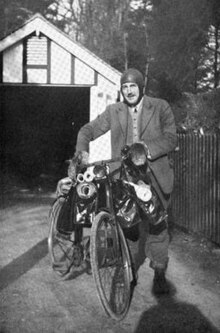O. G. S. Crawford
| Osbert Guy Stanhope Crawford | |
|---|---|

O.G.S. Crawford with bike
|
|
| Born |
28 October 1886 Breach Candy, Bombay, India |
| Died | 28 November 1957 (aged 71) Nursling, Hampshire, UK |
| Nationality | British |
| Occupation | Archaeologist |
| Known for | Aerial photography pioneer |
Osbert Guy Stanhope Crawford (28 October 1886 – 28 November 1957), better known as O. G. S. Crawford, was a British archaeologist who specialised in the study of prehistoric Britain and the archaeology of Sudan. Working for most of his career as the archaeological officer of the Ordnance Survey, he wrote a range of books on archaeological subjects and was a keen proponent of aerial archaeology.
Born in Bombay, British India, to a wealthy middle-class Scottish family, Crawford moved to England as an infant and was raised by his aunts in London and Hampshire. He studied geography at Keble College, Oxford and worked briefly in that field before devoting himself professionally to archaeology. Employed by the philanthropist Henry Wellcome, Crawford oversaw the excavation of Abu Geili in Sudan before returning to England shortly before the First World War. During the conflict he served in both the London Scottish Regiment and the Royal Flying Corps, where he was involved in both ground and aerial reconnaissance along the Western Front. After an injury forced a period of convalescence in England, he returned to the Front, where he was captured by the German Army in 1918 and held as a prisoner of war until the end of the conflict.
In 1920 he was employed by the Ordnance Survey. In this position he toured Britain to plot the location of archaeological sites in the landscape, in the process identifying several previously unknown sites. Increasingly interested in aerial archaeology, he obtained aerial photographs produced by the Royal Air Force and identified the extent of the Stonehenge Avenue, excavating it in 1923. With the archaeologist Alexander Keiller he conducted an aerial survey of many counties in southern England and raised the finances to secure the land around Stonehenge for The National Trust. In 1927, he established the scholarly journal Antiquity, which contained contributions from many of Britain's most prominent archaeologists, and in 1939 he served as president of The Prehistoric Society. An internationalist and socialist, he came under the influence of Marxism and for a time became a Soviet sympathiser. During the Second World War he worked with the National Buildings Record, photographically documenting Southampton. After retiring in 1946, he refocused his attention on Sudanese archaeology and wrote several further books prior to his death.
...
Wikipedia
